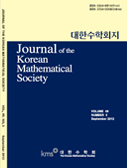Journal of the
Korean Mathematical Society
JKMS
Most Read
 VIEW ARTICLES
VIEW ARTICLES
 Most Read
Most Read
-
2022-05-01
On weighted compactness of commutators of bilinear fractional maximal operator
Qianjun He, Juan ZhangAbstract : Let $\mathcal{M}_{\alpha}$ be a bilinear fractional maximal operator and $BM_{\alpha}$ be a fractional maximal operator associated with the bilinear Hilbert transform. In this paper, the compactness on weighted Lebesgue spaces are considered for commutators of bilinear fractional maximal operators; these commutators include the fractional maximal linear commutators $\mathcal{M}_{\alpha,b}^{j}$ and $BM_{\alpha, b}^{j} $ $(j=1,2)$, the fractional maximal iterated commutator $\mathcal{M}_{\alpha,\vec{b}}$, and $BM_{\alpha, \vec{b}}$, where $b\in{\rm BMO}(\mathbb{R}^{d})$ and $\vec{b}=(b_{1},b_{2})\in{\rm BMO}(\mathbb{R}^{d})\times {\rm BMO}(\mathbb{R}^{d})$. In particular, we improve the well-known results to a larger scale for $1/2
-
2022-05-01
Boundedness of Calder\'{o}n-Zygmund operators on inhomogeneous product Lipschitz spaces
Shaoyong He, Taotao ZhengAbstract : In this paper, we study the boundedness of a class of inhomogeneous Journ\'{e}'s product singular integral operators on the inhomogeneous product Lipschitz spaces. The consideration of such inhomogeneous Journ\'{e}'s product singular integral operators is motivated by the study of the multi-parameter pseudo-differential operators. The key idea used here is to develop the Littlewood-Paley theory for the inhomogeneous product spaces which includes the characterization of a special inhomogeneous product Besov space and a density argument for the inhomogeneous product Lipschitz spaces in the weak sense.
-
2023-03-01
Time periodic solutions to a heat equation with linear forcing and boundary conditions
In-Jee Jeong, Sun-Chul KimAbstract : In this study, we consider a heat equation with a variable-coefficient linear forcing term and a time-periodic boundary condition. Under some decay and smoothness assumptions on the coefficient, we establish the existence and uniqueness of a time-periodic solution satisfying the boundary condition. Furthermore, possible connections to the closed boundary layer equations were discussed. The difficulty with a perturbed leading order coefficient is demonstrated by a simple example.
-
2022-11-01
The Difference of Hyperharmonic Numbers via Geometric and Analytic Methods
Abstract : Our motivation in this note is to find equal hyperharmonic numbers of different orders. In particular, we deal with the integerness property of the difference of hyperharmonic numbers. Inspired by finiteness results from arithmetic geometry, we see that, under some extra assumption, there are only finitely many pairs of orders for two hyperharmonic numbers of fixed indices to have a certain rational difference. Moreover, using analytic techniques, we get that almost all differences are not integers. On the contrary, we also obtain that there are infinitely many order values where the corresponding differences are integers.
-
2023-07-01
Cup product on relative bounded cohomology
HeeSook ParkAbstract : In this paper, we define cup product on relative bounded cohomology, and study its basic properties. Then, by extending it to a more generalized formula, we prove that all cup products of bounded cohomology classes of an amalgamated free product \( G_{1}\ast_{A}G_{2} \) are zero for every positive degree, assuming that free factors \( G_i \) are amenable and amalgamated subgroup \( A \) is normal in both of them. As its consequences, we show that all cup products of bounded cohomology classes of the groups \( \mathbb{Z} \ast \mathbb{Z} \) and \( \mathbb{Z}_{n} \ast_{\mathbb{Z}_{d}}\mathbb{Z}_m \), where \( d \) is the greatest common divisor of \( n \) and \( m \), are zero for every positive degree.
-
2023-07-01
Some algebras having relations like those for the 4-dimensional Sklyanin algebras
Alexandru Chirvasitu, S. Paul SmithAbstract : The 4-dimensional Sklyanin algebras are a well-studied 2-parameter family of non-commutative graded algebras, often denoted $A(E,\tau)$, that depend on a quartic elliptic curve $E \subseteq \mathbb{P}^3$ and a translation automorphism $\tau$ of $E$. They are graded algebras generated by four degree-one elements subject to six quadratic relations and in many important ways they behave like the polynomial ring on four indeterminates except that they are not commutative. They can be seen as ``elliptic analogues'' of the enveloping algebra of $\mathfrak{gl}(2,\mathbb{C})$ and the quantized enveloping algebras $U_q(\mathfrak{gl}_2)$. Recently, Cho, Hong, and Lau conjectured that a certain 2-parameter family of algebras arising in their work on homological mirror symmetry consists of 4-dimensional Sklyanin algebras. This paper shows their conjecture is false in the generality they make it. On the positive side, we show their algebras exhibit features that are similar to, and differ from, analogous features of the 4-dimensional Sklyanin algebras in interesting ways. We show that most of the Cho-Hong-Lau algebras determine, and are determined by, the graph of a bijection between two 20-point subsets of the projective space $\mathbb{P}^3$. The paper also examines a 3-parameter family of 4-generator 6-relator algebras admitting presentations analogous to those of the 4-dimensional Sklyanin algebras. This class includes the 4-dimensional Sklyanin algebras and most of the Cho-Hong-Lau algebras.
-
2023-01-01
Pseudo-Riemannian Sasaki solvmanifolds
Diego Conti, Federico A. Rossi, Romeo Segnan DalmassoAbstract : We study a class of left-invariant pseudo-Riemannian Sasaki metrics on solvable Lie groups, which can be characterized by the property that the zero level set of the moment map relative to the action of some one-parameter subgroup $\{\exp tX\}$ is a normal nilpotent subgroup commuting with $\{\exp tX\}$, and $X$ is not lightlike. We characterize this geometry in terms of the Sasaki reduction and its pseudo-K\"ahler quotient under the action generated by the Reeb vector field. We classify pseudo-Riemannian Sasaki solvmanifolds of this type in dimension $5$ and those of dimension $7$ whose K\"ahler reduction in the above sense is abelian.
-
2022-09-01
New congruences for $\ell$-regular overpartitions
Ankita Jindal, Nabin K. MeherAbstract : For a positive integer $\ell$, $\overline{A}_{\ell}(n)$ denotes the number of overpartitions of $n$ into parts not divisible by $\ell$. In this article, we find certain Ramanujan-type congruences for $\overline{A}_{ r \ell}(n)$, when $r\in\{8, 9\}$ and we deduce infinite families of congruences for them. Furthermore, we also obtain Ramanujan-type congruences for $\overline{A}_{ 13}(n)$ by using an algorithm developed by Radu and Sellers [15].
-
2023-03-01
Unconditional stability and convergence of fully discrete FEM for the viscoelastic Oldroyd flow with an introduced auxiliary variable
Huifang Zhang, Tong ZhangAbstract : In this paper, a fully discrete numerical scheme for the viscoelastic Oldroyd flow is considered with an introduced auxiliary variable. Our scheme is based on the finite element approximation for the spatial discretization and the backward Euler scheme for the time discretization. The integral term is discretized by the right trapezoidal rule. Firstly, we present the corresponding equivalent form of the considered model, and show the relationship between the origin problem and its equivalent system in finite element discretization. Secondly, unconditional stability and optimal error estimates of fully discrete numerical solutions in various norms are established. Finally, some numerical results are provided to confirm the established theoretical analysis and show the performances of the considered numerical scheme.
-
2023-09-01
The first positive and negative Dirac eigenvalues on Sasakian manifolds
Eui Chul KimAbstract : Using the results in the paper [12], we give an estimate for the first positive and negative Dirac eigenvalue on a 7-dimensional Sasakian spin manifold. The limiting case of this estimate can be attained if the manifold under consideration admits a Sasakian Killing spinor. By imposing the eta-Einstein condition on Sasakian manifolds of higher dimensions $2m+1 \geq 9$, we derive some new Dirac eigenvalue inequalities that improve the recent results in [12, 13].

Most Read
-
Regularity relative to a hereditary torsion theory for modules over a commutative ring
Lei Qiao, Kai Zuo
J. Korean Math. Soc. 2022; 59(4): 821-841
https://doi.org/10.4134/JKMS.j210774 -
On solvability of a class of degenerate Kirchhoff equations with logarithmic nonlinearity
U\u{g}ur Sert
J. Korean Math. Soc. 2023; 60(3): 565-586
https://doi.org/10.4134/JKMS.j220129 -
A note on unicity of meromorphic functions in several variables
yezhou Li, heqing sun
J. Korean Math. Soc. 2023; 60(4): 859-876
https://doi.org/10.4134/JKMS.j220473 -
Thomas algorithms for systems of fourth-order finite difference methods
Soyoon Bak, Philsu Kim, Sangbeom Park
J. Korean Math. Soc. 2022; 59(5): 891-909
https://doi.org/10.4134/JKMS.j210701
Most Downloaded
-
Topologically stable points and uniform limits
Namjip Koo, Hyunhee Lee
J. Korean Math. Soc. 2023; 60(5): 1043-1055
https://doi.org/10.4134/JKMS.j220595 -
Continuum-wise expansiveness for $C^1$ generic vector fields
Manseob Lee
J. Korean Math. Soc. 2023; 60(5): 987-998
https://doi.org/10.4134/JKMS.j220359 -
Robust portfolio optimization under hybrid CEV and stochastic volatility
Jiling Cao, Beidi Peng, Wenjun Zhang

J. Korean Math. Soc. 2022; 59(6): 1153-1170
https://doi.org/10.4134/JKMS.j210728 -
On uniformly $S$-absolutely pure modules
Xiaolei Zhang
J. Korean Math. Soc. 2023; 60(3): 521-536
https://doi.org/10.4134/JKMS.j220055
Editorial Office
JKMS
© 2022. The Korean Mathematical Society. Powered by INFOrang Co., Ltd






